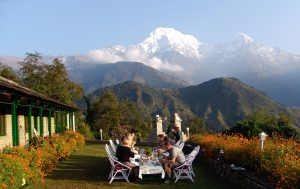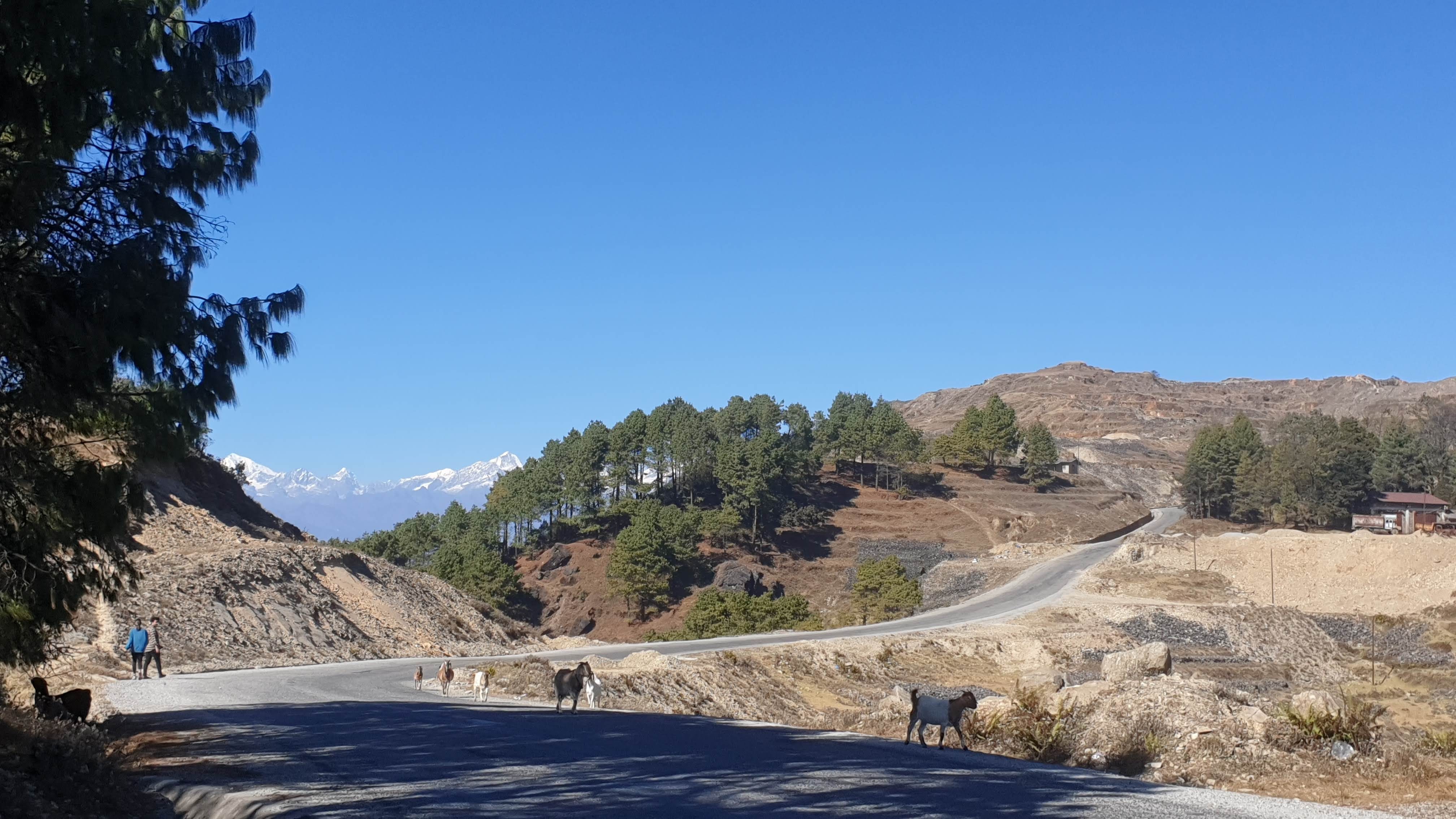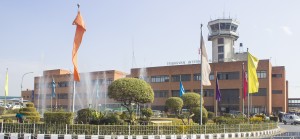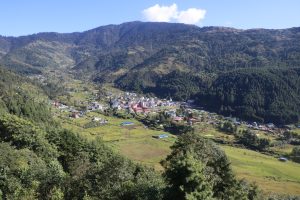Forget Covid-19 and think of places you can visit after the lockdown
Perhaps some of you have been tired of hearing about the coronavirus crisis and its impact on daily life, time and again. Obviously, it is important for you to get aware of what’s happening in the world due to the newly discovered virus and keep yourself protected. However, it is also time to get away with the Covid-19 obsession.
Before the lockdown began, Onlinekhabar had presented you two travel stories about Dolakha. Now, it’s time to go through the final part.
—
Dolakha’s Tripura Sundari (Goddess Bhagawati), closely associated with the legend of the town, succeeds as another most revered deity after Bhimeswor. Housed in a temple-building called Devikot, the sacred site is located some 200 yards down stone stairs from the Bhimeswor Temple. The building was recently rebuilt after it was razed to the ground by the April 2015 earthquake.
Tucked away on a quiet and isolated forested ridge, the temple premises is adjoined by a beautiful park called Champuja, which treats the visitors with a stunning view of the Gaurishankar Himal, the Sunkhani village on the other side of the hill followed by the Dolti river valley and lush rolling hills that drop steeply to the river Tamakoshi. A dense forest called the Kanlad skirts the edifice on three sides.
At Tripura Sundari, visitors are barred from viewing the main deity. Only the main priest is entitled to perform a puja on behalf of the devotees. Believed by the local folks to have been built before the Mahabharat era or the Dwapar Yuga, this shrine is shrouded in mystery and occult beliefs.
“In the olden times, people feared to visit this temple premises after sundown,” says Shyam Shrestha, a member of the temple guthi (trust). Those who mistakenly wandered off to the temple surroundings after sunset went missing; they were devoured by the demons that lurked nearby the site,” reveals Shrestha. Surprisingly, the locals of Dolakha still hold the deity with fear and respect and balk at the idea of visiting the temple after dark.

Newar settlement
Home to a rich culture and tradition, Dolakha town is predominantly a Newar settlement. The Newari dialect from Dolakha is, however, way different from that of Kathmandu. Nonetheless, both languages have some words with identical meanings, like ja (rice), baji (beaten rice), chen (house), khan (talk), Mahani (the Dashain festival), kija (brother), kehen (sister), to cite a few.

Like their peers in Kathmandu, the Newars from Dolakha are represented by Shresthas, Pradhans, Joshis, Maskeys, and Rajbhandaris. Going by the Puranas (ancient scripture), the Dolakha language saw its birth during the Mahabharat era when the Panch Pandavas (the protagonists of the epic), sentenced to one year in exile, went into hiding in Dolakha.


To keep themselves incognito, the five Pandava brothers conceived this unique dialect. Another school of thought, however, believes that the Dolakha language has its roots in Kathmandu Newari and was introduced by itinerant traders and government incumbents assigned to the town for a prolonged sojourn. Some, however, argue that the people of Dolakha evolved their indigenous language to suit local customs and environment, and may have adapted a little from the migrant Newari dialect from Kantipur or ancient Kathmandu. The issue is still in the dark and open to controversy. And the history of ancient Nepal has little to offer.

Curiously, the Dolakha dialect also embraces expressions from other ethnic communities like the Thamis, the Sherpas, and the Tamangs. Amazing as it may sound, even the Bengali word ‘taka’ meaning currency is used in the Dolakha dialect with the identical meaning. This seems to offer linguists a challenging case fora deeper study.
Bucket list
While in Dolakha, your itinerary can include a cluster of unique destinations on your bucket list. Short hikes can allow room for a trip to Nagdaha, Sunkhani, Busti, and Saharpa to enjoy the pristine countryside, or make your mouth water with fresh-caught asla (snow trout) from the river Tamakoshi at the teahouses at Nayapul, some 20 km away.
Given a clear morning, the village folks claim a short 45-minute walk to the crest of a hill called Trishulcha, north of the Dolakha Bazaar, allows you to clap your eyes on the tallest mountain in the world, Mount Everest (8,848 m) behind a panoply of lofty peaks including Melungtse Himal (7,181m). As the spot also holds a deity, local devotees often visit the place to offer a puja (worship).

A jeep ride from Charikot/Makaibari to the ancient pilgrimage site, the Kalinchok Bhagwati (3,842 m) is a dream destination. Recently, a cable car service came into operation, which shuttles visitors to Kalinchok from Kuri.
Another destination, a Sherpa village called Beding (3,700 m), once referred to as the land of Everest summiteers, is a three-four-day trek, leading to the picturesque Rolwaling Valley at the base of the Gaurishankar—serving as truly a lifetime experience.

For anthropologists, the ethnic Thami villages like Sushpa, Kshyamawati, Khopachagu, Alampu, and Bigu offer a great opportunity to study those rare communities whose numbers are on a rapid dwindling trend.
Jiri, a town often compared with Zurich in Switzerland, is only 55 km away. Before the construction of an airstrip at Lukla, Jiri served as a gateway to Namche and the Khumbu or the Everest Region, and once boasted as the summiteers’ hub.
The trek to Shailung Danda (3,150 m), also known as the ‘land of 100 hills’ is worth its weight in gold. What distinguishes the highland moor is the amazing sight of midget hills that roll out by the hundred. You can take a bus to Mude and trek the dirt road to the spot, some 25 km away. The site also offers another pilgrimage called the Salilungeswor Mahadev at an elevation of 3,500 m.

The high elevation of Shailung affords a stunning Himalayan panorama stretching from Dhaulaigiri, Annapurna, the entire Langtang Range to Ganesh Himal and the Rolwaling region. To the north, stands high the Kalinchok ridge. It is said a distant view of Kathmandu Valley in the north-west and the Tarai plains in the south can be viewed on a clear morning.
If you fancy visiting monasteries, a two-day trek to a village called Bigu will charm you with its seminary for Buddhist nuns (anis). Or, maybe you are hung up on some hardcore trekking and wish to attempt Tsho Rolpo, Nepal’s biggest glacier at 4,581m, which was once under threat of bursting in the late 1990s. You will, however, need professional help, and specific gear for this is an arduous trek.
For accommodations, Dolakha has a number of lodges and resorts catering to your needs. Visitors can also stay the night in Charikot, 4.5 km away, if need be.
Folklore and myths
Apart from a rich culture and history, Dolakha is shrouded in folklore and dark mystery. The village elders in Dolakha still believe those who perform as Gods, in the Khadga Jatra celebrated every Dashain, are visited by the Gods–and a few chosen ones, are possessed. The festival marks the triumph of virtue over the forces of evil as the Gods put an end to the terror begot by the danavs (demons). Pitched battles take place between the gods and the demons as a part of the festival.
A wooded hill southwest of the town called the Saharpa has weird lore attached to it. “During the days of our forefathers, people from Korchhe Tole (street) often went to Saharpa Danda (hill) to collect firewood. That went on for many years,” Parwati Shrestha from the Tallo Tole said as she recounted the bizarre happening that took place.
“One day, however, a strange incident took place at Saharpa,” she continued. “A group of woodcutters turned mute on their return to their neighbourhood. That occurred again with a band of another group from Korchhe. Now, that was a serious matter. So, a shaman was summoned to find the solution followed by a puja to the forest goddess at Saharpa. Miraculously, people stopped getting mute after that,” she concluded. The Saharpa hills can be easily sighted from Dolkha town.

Coup de grace
On April 25, 2015, the ground beneath the quiet little town shook violently as the massive 7.6 magnitude earthquake jolted Nepal. The Dolakha district, among others, was the hardest hit. Still reeling from the traumatic condition with a great loss of life and property, Dolakha was struck again on May 12, 2015, by another disastrous 7.3 magnitude quake bringing in its wake further devastation that dealt a crippling blow to the already tottering infrastructure.

Almost 90 per cent of the historical monuments and relics were razed to the ground by the quake. Apart from the great loss of human lives, the town looked all but a grisly scene of mass destruction and mayhem. By some small miracle, the Bhimeswor, the most revered temple of the Dolakhes (people of Dolakha town), save for some minor damages, survived unscathed.
Dolakha, however, lost virtually all those vintage stone-and-mortar houses, which had survived the epic earthquake of 1934 (1990 BS). One such house included my grandfather’s, which had weathered 150 years and lived in by three generations. But miracles do happen. An older than 300-years-old house survived the earthquake (view picture in this story’s part II).
It seemed the ill-fated town would never regain its former self. Dolakha revived from the catastrophe slowly, though. It took almost three hard years to get back on her feet again. The famed Tripura Sundari Temple, reduced to rubbles by the large temblors, is rebuilt today. So are more than 90 per cent of other relics and monuments scattered around the town to their past splendour.

It looks like Dolakha has lost none of its enduring charisma and promise, both as a pilgrimage and a memorable getaway. The people of Dolakha have proudly preserved their ancient relics and monuments and upheld their faith in their tradition, culture and religion to this day. And the tiny medieval town still stays to charm curious visitors time and again.






















